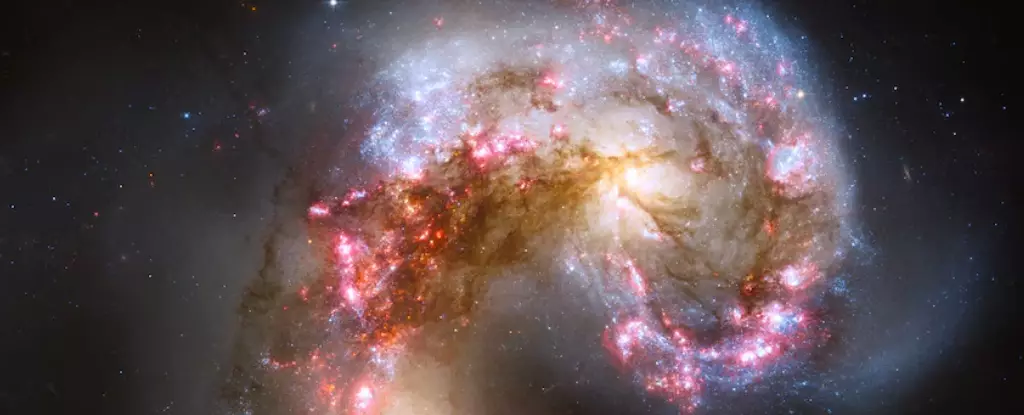The fascination with the cosmos is perpetual, emanating a blend of humility and motivation as we continuously uncover layers of complexity. Recent advancements in our understanding of the Universe have led to significant findings published in the journal Nature by a collective of researchers exploring the enigmatic formation of massive elliptical galaxies. This article delves into how these findings illuminate our understanding of galaxy evolution and reshape existing paradigms in astrophysics.
Galaxies are typically classified into two principal categories: spiral and elliptical. Spiral galaxies, exemplified by our Milky Way, are characterized by their flat, rotating disks rich in gas and stars, which are in a state of continuous formation. In stark contrast, elliptical galaxies take on a more spherical form, reminiscent of a rugby ball, and are predominantly composed of stars that originated over 10 billion years ago. Unlike their spiral counterparts, these galaxies exhibit little to no ongoing star formation. Historically, explaining the genesis of elliptical galaxies has presented a considerable challenge to astrophysical models, particularly those mapping the Universe’s evolution from the Big Bang onwards.
One of the primary hurdles in understanding elliptical galaxies has been the notion that star formation during their initial development occurred within expansive, rotating disks—similar to the mechanism that dictates the formation of spiral galaxies. This raises a compelling question: what processes drove the transition from a flat, disc-shaped star formation model to the distinctly three-dimensional configuration characteristic of elliptical galaxies?
Recent research involving data from the Atacama Large Millimeter/submillimeter Array (ALMA) has provided pivotal insights into the birth of these massive ellipticals. The study focused on dust distributions within over 100 distant galaxies, estimated to be between 2.2 and 5.9 billion years old. Dust serves as a crucial indicator of gas presence—the fundamental material necessary for star formation. What the researchers uncovered was startling: rather than exhibiting the expected flat, disc-like structure, the dust in these early galaxies appeared to be highly compact.
Employing an innovative observational approach, the research team was able to infer the three-dimensional layouts of dust-emitting regions. The results suggested that these early star-forming galaxies were spherical in shape, strongly resembling present-day elliptical galaxies. These observations challenge long-held assumptions about galaxy structure and star formation processes during the earlier epochs of the Universe.
The research did not merely stop with observational data; it leveraged cosmological computer simulations to interpret the findings further. These simulations revealed that the mechanisms fostering the aggregation of dust and gas into the cores of these distant galaxies stemmed from a combination of external influences, including cold gas streams from nearby galaxies and interactions or mergers between these massive structures. This phenomenon appears to have been common in the early Universe, leading to rapid formation processes that facilitated the genesis of elliptical galaxies.
The implications of these findings fundamentally challenge and expand our comprehension of galactic evolution. What was historically considered a slow, methodical process may, in fact, be the result of energetic interactions and rapid accretion of material.
A key element in this breakthrough was the development of an advanced technique to analyze ALMA observations. Unlike the familiar optical telescope images, ALMA employs the method of interferometry by synchronizing data from multiple antennas to create detailed images of distant heavenly bodies. This sophisticated approach allows astronomers to obtain sharper images but presents complexities in data analysis. The research utilized archival, open-access ALMA datasets, emphasizing the substantial role of collaborative scientific efforts and transparency in fueling advancements in astrophysics.
As we look to the future, the advent of next-generation telescopes, such as the James Webb Space Telescope (JWST) and the upcoming Euclid space telescope, promises to further advance our understanding of galaxy evolution. With these instruments, astronomers will not only map the distribution of stars in galaxies but will also gain unparalleled insights into the dynamics of gas processes within them.
The findings discussed here add a significant chapter to the ongoing narrative of cosmic understanding. The swift evolution of elliptical galaxies from their formative years challenges pre-existing models and encourages the astrophysical community to reconsider notions of galaxy formation. As emerging techniques and new observational tools continue to refine our perspective, we are reminded of the profound and intricate tapestry that constitutes our Universe—a reminder that the journey of discovery is as critical as the findings themselves.


Leave a Reply